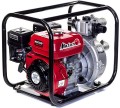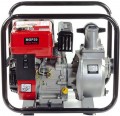Maximum performance
The maximum volume of water that the device can pump in a certain amount of time. It is one of the key specs of any pump because characterizes the volume of water with which the device can work. At the same time, it does not always make sense to pursue maximum performance — after all, it significantly affects the dimensions and weight of the unit.
Some formulas allow you to derive optimal performance values for different situations. So, if the pump is designed to supply water to water intake points, its minimum required performance should not be lower than the highest total flow rate; if desired, a margin of 20-30% can be added to this value. And for sewer models (see "Suitable for"), everything will depend on the volume of wastewater. More detailed recommendations for choosing a pump depending on performance can be found in special sources.
Maximum head
The maximum head generated by the pump. This parameter is most often indicated in meters, by the height of the water column that the unit can create — in other words, by the height to which it can supply water. You can estimate the pressure created by the pump using a simple formula: every 10 m of head corresponds to a pressure of 1 bar.
It is worth choosing a pump according to this parameter, taking into account the height to which it should supply water, as well as adjusting for losses and the need for pressure in the water supply. To do this, it is necessary to determine the difference in height between the water level and the highest point of water intake, add another 10 to 30 m to this figure (depending on the pressure that needs to be obtained in the water supply), and multiply the result by 1.1 — this will be the minimum pressure required.
Maximum particle size
The largest particle size that the pump can handle without problems. This size is the main indicator that determines the purpose of the device (see above); and in general, the larger it is, the more reliable the device, the lower the risk of damage if a foreign object enters the suction line. If the risk of the appearance of too large mechanical impurities is still high, additional protection can be provided with filters or grids at the inlet. However, such a measure should be considered only as a last resort, because from constant exposure to solid particles, the grids become clogged and deformed, which can lead to both clogging of the line and filter breakthrough.
Dry run protection
A system that protects the unit from running without water.
The dry running mode is abnormal for any pump: at best, the mechanism of the unit in this mode experiences increased loads, and at worst, the device may fail and even a serious accident. This feature allows you to prevent such consequences. The specific method of protection against dry running may be different; one of the most popular options is a float switch (see below). However, in addition, flow sensors, pressure or level switches can be used. These details depend both on the general type of pump and on the specific model; they should be specified separately in each case.
Oil tank volume
The volume of the oil tank installed in the water pump with the engine(see "Type"). This characteristic, first of all, allows you to estimate how much oil is needed for the first refuelling of the pump — the tank must be filled to the full volume.
Impeller / auger material
The material from which the main working element of the pump is made is an impeller, an auger or a membrane. This part is in direct contact with the pumped liquid, so its specs are key to the overall performance and capabilities of the pump.
— Plastic. Plastic is low-cost, and it is not subject to corrosion. It is believed that the mechanical strength of this material is generally low, and it does not tolerate contact with solid impurities. However, today there are many varieties of plastic — including special high-strength varieties that are suitable even for working with heavily polluted water or sewage. So plastic impellers/augers can be found in a variety of types of pumps; the overall quality and reliability of such parts, usually, depend on the price category of the unit.
— Cast iron. Solid, durable, reliable and, at the same time, relatively inexpensive material. In terms of corrosion resistance, cast iron is theoretically inferior to more advanced alloys like stainless steel or aluminium; however, subject to the operating rules, this point is not critical, and the service life of cast iron parts is no less than the total service life of the pump. The unequivocal disadvantages of this option include a large mass, which slightly increases the energy/fuel consumption during operation.
— Stainless steel. By the name, one of the key advantages of stainless steel is high resistance to corrosion — and, accordingly, reliability and durabili...ty. Such an alloy is somewhat more expensive than cast iron, but it also weighs less.
— Aluminium. Aluminium alloys combine strength, reliability, corrosion resistance and low weight. However, such materials are quite expensive — more expensive than the same stainless steel, not to mention cast iron.
— Brass. The varieties of brass used in pumps are distinguished by high strength and hardness, as well as insensitivity to moisture. Such materials are quite expensive, but this price is fully justified by the mentioned advantages. Therefore, in certain types of pumps — in particular, surface models and pressure tank units — brass impellers are very popular.
— Bronze. A material similar in many properties to the brass described above. However, bronze is used much less frequently — in particular, due to a slightly higher cost.
— Steel. Varieties of steel that are not related to stainless steel are used extremely rarely — in certain models of pumps for chemical liquids. At the same time, steel is usually used as a base in such parts, and a coating of fluoroplastic or other similar material is applied to it to protect it from corrosion.
— Silumin. Silumins are called aluminium alloys with the addition of silicon. For several reasons, such materials are rare in pumps, and mainly among relatively inexpensive models.
— Rubber. Material traditionally used for diaphragms in vibratory pumps (see “Pump type”).

